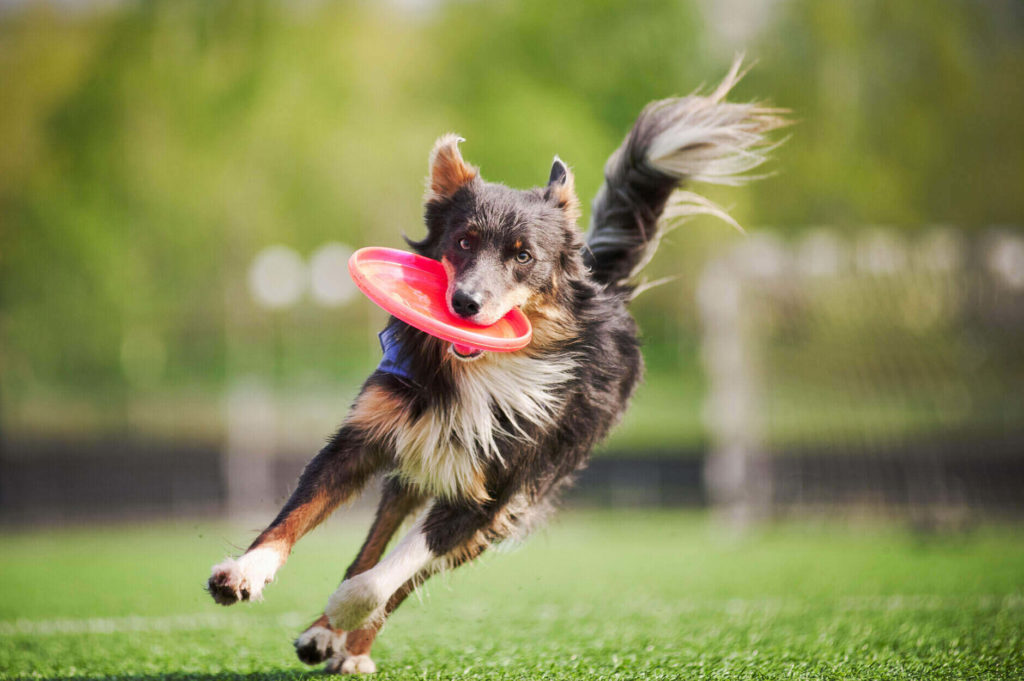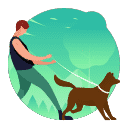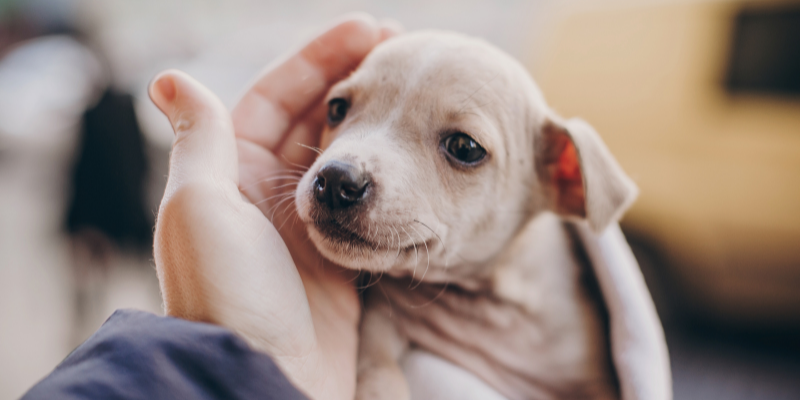THE ULTIMATE GUIDE TO ADOPTING A DOG:
Everything You Need To Know To Get Your 1st Pet, Hassle-Free
So you’re looking at adopting a dog?
Welcome to the journey of pet parenthood. We know how tough the process of getting a new pet can be, so we’ve put together a guide for first-time pet-adopters to make things a little easier.
Adopting a dog is an adventure, so be prepared for plenty of fun, love, and play, most likely with a couple of bumps along the way – that’s what this guide is for.
Ready to start the process? Let’s get right into it – from start to finish.


Deciding to Adopt a Dog
It all starts with the idea, the thought of a happy, fluffy little thing bouncing around the house.
But choosing to add a dog to your family is a big decision.
You’ll need to make sure that this is going to be a great move for you (and your family) as well as for your new furry companion.
Here are a few important things you’ll need to think about before making your decision.
Adopt Or Buy? The Case For Adoption
There are many ways to get a dog.
You can buy from a pet store, you can buy from a breeder, and you can even get one off of Craigslist these days (which could be considered adopting in some cases).
While there are some great breeders out there and some pet stores who treat their pets very well, we recommend adopting from a shelter for a few reasons:
1) You’re saving a pup who might otherwise be killed
Shelter dogs are unfortunately likely to end up being euthanized if they aren’t adopted.
This is to prevent shelters becoming overcrowded, but no pooch should be killed simply because they take up space.
Adopting a shelter dog is, literally, saving a life.
2) It’s cheaper than buying from a breeder
Why spend thousands when you can get a loyal, loving companion for a small adoption fee?
This is not only the smarter way to go financially, but it leaves you more to spend on essentials like dog bedding, dog food, toys, and puppy-proofing your house.
3) You won’t be supporting puppy mills
A puppy mill is basically an under-the-table breeder whose intention is to churn out money-making pups with little to no regard for the conditions in which they are kept.
Not only is this detrimental to the dogs used to breed with, it’s also severely unhealthy for puppies.
And if you really need another reason …
4) All the cool kids are doing it
Celebrities love their rescues!
Emmy Rossum is a great example of a celebrity who is a proud advocate for rescue pets. The actress owns 4 rescues (3 dogs, Cinnamon, Sugar, and Pepper, and a cat, Fiona), and is outspoken about the benefits of adopting instead of buying (for the pup and the human!)
What To Consider Before Deciding To Adopt
Once you’ve decided that adopting a pup in need would be awesome (and your family are on board), here are a few more things you need to take a look at to make sure you can support yourself, your family, and the newest doggy addition.
Finances
Although adopting a dog is cheaper than buying, there are other costs that come along with having a pooch in the house.
Regular expenses like dog food, treats, shots (if you have a puppy), training classes and trips to the groomer, as well as less frequent buys such as bedding, microchipping, toys, and accessories (brushes, crates, and various others) need to be taken into consideration.
You also need to remember that the occasional emergency expense can pop up – for example, if your pup chews on something they shouldn’t and needs to be rushed to the vet. If you think you can afford to adopt a dog, the next thing to pay some attention to is …
Time
Dogs are social animals. You’ll need to have time (either you or your family) to bond with your pup, play with them, exercise them, train them or take them to training, and make them feel like part of the family.
If you’re going to adopt a dog and be away from the house 12 hours a day and leave them to their own devices, a goldfish may be the better pet for you.
Space
Dogs need space. Sure, a Yorkie will need less of it than a Labrador, but you’ll need to make sure your home can accommodate a pet.
Large dogs will need a yard, and while small dogs may need less garden to run around in, they’ll need enough room to be comfortable and not feel boxed in.
Reason
Why do you want to adopt a dog? Remember, adopting a pup should be in the dog’s best interest, as well as yours.
You should have a good amount of excitement, joy, and anticipation for this adoption. If you aren’t adopting a dog for the right reasons, you should reconsider.
Pro Tips:
Check the adoption paperwork in advance – there may be restrictions that could alter your decision.
Think ahead – what will you do if your dog suffers from separation anxiety? How will you handle it if your dog is a digger? What will you do with your dog when you and your family go on holiday? Have a plan!

Choosing A Dog To Adopt
Once you’ve considered the above and decided to adopt, choose what type of dog would be best for you.
You may arrive at a shelter and fall in love with a pup totally different to what you’re expecting, but having an idea of what kind of dog you’re looking for will be quite a big help to make the preparation for your new pet easier.
Breed
If you have a specific breed in mind, do extensive research on it.
Everything from dietary requirements, common health issues, and exercise, to how they interact with children, what kind of watch dogs they are, and if they’re prone to digging is information that will help you make your choice.
This is essential, as certain dog breeds (for example, brachycephalic dogs) have specialized needs that you will have to be aware of from the start.
If you have a specific breed in mind, do extensive research on it.
Everything from dietary requirements, common health issues, and exercise, to how they interact with children, what kind of watch dogs they are, and if they’re prone to digging is information that will help you make your choice. This is essential, as certain dog breeds (for example, brachycephalic dogs) have specialized needs that you will have to be aware of from the start.
If you have no idea what breed to go for, start by choosing between small, medium, or large. This will obviously depend on the amount of space you have and how much food you can afford to feed your new addition, but it’s a good starting point. From there, you can start looking into specifics, such as if they’re good with kids or destructive, and so on. It’s also a good idea to look at the more common and more rare dog breeds, as you may struggle to find rare breeds in shelters.
Temperament
Do you want a dog that will play happily with small children? Or do you want a dog that will be intimidating and threatening to strangers? These are important things to think about when adopting a dog.
If there are children or other pets in the house, you’ll most likely want a pup that is more gentle, but still playful. If you live alone and you want an extra bit of security, you may choose a dog that is very alert and protective. For older dog owners who may not have as much time for physical activities or regular exercise, less active dogs are more ideal.
Activity Level
Certain breeds are naturally more active than others. If your adopted pup will have a yard to run free in, you can consider very active pups such as Labradors. If your pooch will be a house-dog, something like a Pekingese might be the better option.

Practicality
There are other things to consider purely from a practical point of view.
Are you okay with a dog that sheds? All do to some extent, but some are serious shedders. Do you want a puppy, or are you happy to go for an older dog? Would you prefer a dog that is already spayed or neutered, or are you happy with a pup who isn’t?
Don’t fall into the trap of going in without any particular dog in mind and coming back to your one bedroom flat and 12-hour a day job with a German Shepherd because you fell in love with his face!
Be sure that you know what will and what won’t work for you based on what you can provide for your new pup.
Pro Tips:
Don’t dismiss more senior dogs. Depending on your lifestyle, a senior may be the perfect choice for you!
List the dogs that won’t work for you, based on your lifestyle. This way, you can immediately avoid them when at the shelter. This may sound harsh, but getting a dog that won’t fit or be happy in your space won’t help either of you.

Preparing For Your Dog
Before you rush out and bring back a fluffy new member of the family, it’s a great idea to make sure that your home is kitted out to make it as easy and comfortable as possible for the humans and the new pup to settle in together.
Adopting a dog can bring with it more challenges than one realizes at first, so here are some things you should look at doing and buying before bringing your new pooch home to avoid chaos ensuing.
Dog-Proofing Your House
Throwing a dog into your pristine home can be a recipe for disaster. Dogs who are nervous as a result of having been a stray or surrendered by previous owners and are now in a new, unfamiliar place, will be especially jumpy and prone to accidents and compulsive behaviour during the first little while of being in your home.
Keep in mind that dog-proofing is about making your home safe for your new pup – not making your pup safe for your home. Some accidents are bound to happen, but these can be improved and eventually eliminated with training and establishing boundaries once your pup has gotten over the initial nervousness of being in a new place with new people.
Step #1: Assess What Is Chewable And Remove Dangers
Some common chewable things that can be seriously hazardous to pups are toxic plants, medications, power cords, sharp objects, and things that can be swallowed and choked on.
Make sure medications, human food, small objects and sharp things are stored out of the way, either on shelves your pup won’t reach or in cupboards that your pup can’t open. Power cables and electrical wires need to be kept out of reach of dogs as far as possible. If your cables need to run along the floor or somewhere easy for your pup to reach, make a plan to enclose them in something your pooch can’t chew through.
Step #2: Assess What Can Be Opened, and Find Ways To Keep Them Closed
Trash cans, toilets, doors, and cupboards can house dangers to dogs, and can be opened by determined (and bored) pets if they try hard enough.
The simplest solution is to keep doors closed if you don’t want your pet accessing something in that particular room. If you’d prefer to keep them open, child-proof latches on cupboards can be very helpful.
Buying a closed trash can is a good idea if you don’t want to come home to your kitchen covered in garbage, and keeping the toilet seat down will prevent curious pets from getting stuck and potentially drowning, or simply getting covered in not-so-hygienic liquid.
If your pup has figured out how to open trash can lids and toilet seats, you’ll need to be a little more creative in figuring out how to keep these down. Latches, hooks, and duct tape are all useful options!
Step #3: Expect Some Accidents
Remember, when you bring your pup home, they’ll take some time to get used to their new surroundings. Although you will spend some time teaching them the house rules and training them, it’s likely you will come home to the occasional chewed-up sofa, peed-upon carpet, and knocked over ornament. Be patient and keep dog-proofing as you discover new things that need to be done!

Stocking Up For Your Dog’s Arrival
Once your home is dog-safe, there are some things you’ll want to buy to make sure your new family member has all they need upon arrival.
Being prepared for his or her arrival will not only help them settle in faster, it will make it far easier for you going forward if most things are organized before the new bundle comes home.
Bedding
Even if you’re intending to have your furry friend sleep in the bed with you, having his own bed is important.
Your dog will need a space of his own, and sharing a bed with his human won’t quite do the trick.
Make sure to get something comfortable, and extra blankets for winter or colder climates!
A washable bed is also preferable, in case of accidents.
Food & Treats
Choosing a high-quality food that is made from natural, whole food ingredients is essential. Real meat as the first ingredient is a standard of high-quality foods, and it’s also generally accepted that foods free of wheat, corn, or soy are the best kinds. Treats high in protein and lower in calories and also made from real, natural ingredients are preferable, no matter what kind of dog you’re bringing home.
Food and Water Bowls
Of course, you’ll need something for your pet to eat and drink out of. Metal bowls are great if you’re worried about your new pet chewing stuff. The size of the bowls will depend on the size of the dog you’re expecting to get.
Collar & Leash or Harness
As mentioned above, it’s a great idea to have a collar and leash with you when fetching your pup from the shelter. Depending on your pet’s level of activity and excitement, you might prefer a harness for taking them for a run. It’s a little more stable and your pet is less likely to slip out of it if they get a fright or get too excited.
Health Insurance
This is something that some pet owners will forgo to save costs, but you don’t want to be without it when an emergency hits. You can read more about the best pet insurance in the UK here, and the top options in the USA here.
Toys
Regardless of the age of the dog you’re adopting, toys are a must. Not only will it keep your pet engaged and assist with boredom, they help with exercise (especially if humans can play with, like balls and ropes) and keep your pup’s jaw strong if it’s a chewable one.
A Crate
You may not need a crate, but if you’re intending to travel with your pet or simply want to give them a corner of their own, a crate is a great idea. Crate training may be required though – not all dogs know what this box is and can feel threatened by it.
Accessories (grooming, odor removal)
It’s always a good idea to have an odor-eliminating product stored away for when you need it. Brushes, shampoos, and other accessories can be bought on an as-you-need basis.
Other Things To Look At Before Bringing Your Pup Home
Grooming
If you have a breed in mind that is very furry and tends to shed, you’ll want to make sure there is a groomer nearby, or find a groomer who can come to the house. Of course, you can always learn to shave and wash your pup yourself, too.
Training
This may be more geared towards adopted puppies, as older dogs may already be trained. A little bit of training can go a long way! Look for trainers or training schools in the area before bringing your new pet home.
Vets
As much as we all hope we won’t have to rush our pup to the vet, regular checkups and shots for younger pups are still a necessary part of having a dog. Make sure there is a reputable vet nearby before getting a pup.

Choosing From Where To Adopt
Deciding where you get your dog from is just as important as deciding which dog to bring home.
It’s best to avoid shelters that have bad reputation and aren’t transparent about the way they work with the animals.
This can help you avoid problems down the line, such as behavioural issues with your new pet due to trauma suffered at the shelter, or health problems from being kept in inhumane conditions.
Choosing A Shelter
You can find a list of shelters in the US here and in the UK here. Don’t just go for the one closest to you – there are some things you should check out before choosing one.
1) Check out their website
If all the pets are described the same way on the site, especially if it’s all positive, it’s best to avoid as they either haven’t taken the time to get to know the animals, or they’re just about business and trying to get dogs out without taking the time to ensure a good match.
2) Contact them and ask some initial questions
Find out some info on their criteria for making pups available for adoption (ie. do they do temperament testing?), if you will be able to have a visit with your prospective new pet outside of the kennel, and if they have a return policy.
While it’s always hoped that all adoption stories are success stories, it says a lot about a shelter if they are unwilling to take back animals if it doesn’t work out.
You’ll want to avoid shelters who are unwilling to give out information, places that don’t differentiate between different personalities in their animals, and shelters that refuse to accept pups back.
3) Read reviews
Find out as much as you can from people who have had direct experience with the shelter. Word of mouth is the best research, so don’t be afraid to reach out and ask questions.
Choosing Your Dog
You should have an idea of the kind of dog you’re looking for when you arrive at the shelter. Be open to finding a pup that is unexpected, but remember your initial requirements for choosing a pup – if you want a pet that doesn’t shed because you have allergies, that adorable fluffy face that you pick without thinking may be a problem in the long run.
If you find a pup that you’re interested in taking home, there are some questions that should be asked before you trot off together.
1) The pup’s history
The shelter staff will be able to tell you if the dog was found as a stray or surrendered by previous owners. This can make a difference, as your new pet’s past experiences will most likely have affected him or her in ways that may manifest in their behaviour.
For example, if a dog was a stray, they may be snappy with their food in the beginning. They will be conditioned to grab food where they can, as on the streets they may not have known when their next meal would come. If they were surrendered, they may suffer from separation anxiety for fear of the same thing happening again.
You will need to be very patient and work around these in the beginning until they start to learn otherwise.
The answer to this question may also be an indication of bigger problems – how did the pup become a stray? Have they had a history of trying to escape from the shelter? Were they surrendered because of a particular negative behavioural trait, or did they owner move or just not want their dog anymore? All of these things tell a lot about a dog.
2) The pup’s behaviour
Other questions that are important for you to know are how the dog behaves in certain situations. The shelter staff may not be able to answer all of these, but they should be able to give you some indication.
- Is he or she comfy around other dogs?
- Has the pup had experience with children? If so, how do they interact?
- Has he or she had experience with cats?
- What’s the pup’s general disposition?
- Do they react differently to men and women?
- Does the pup have a medical history?
- Is there any history of destruction? If so, under what circumstances?
- Where were they kept before? (so that you don’t end up putting them in a potentially traumatic situation)
- Have they exhibited any concerning behaviour at the shelter?
If you’ve done your homework on the shelter and selected a reputable one, the staff should answer your questions honestly. Make sure that all of this info gels with your lifestyle and situation. This is why it’s important to have an idea of what you want and don’t want before you start!
Pro Tips:
Unless it’s a complete YES, don’t take a dog home with you. Wanting a pup half-heartedly is not a good start for either of you.
If you have other pets, call the shelter before and ask if you can bring them with. See how they interact with pups that you are interested in. This will give a good indication of how interaction would be with the adopted pup at home.
Take a collar and leash with you! This will make getting your new pooch into the car much easier. Some shelters provide one, but not all do.

Bringing Your New Pet Home
Once you’ve met your perfect match and done all the necessary adoption things to make them yours, the real fun begins – getting your new family member home, settled, and comfortable in his or her new space.
It can be a stressful experience for both you and your new friend, so here are some tips and tricks to keep it as relaxed as possible.
The Car Trip
Getting your adopted dog from the shelter to your home may be a bit of an adventure.
Chances are, the pooch is going to be super excited and probably quite bouncy. The other side of the coin is a quiet, shy pup who doesn’t quite know what to do with themselves.
There are some things you can do to make their car ride home easier and more comfortable for you both.
1) Take their new blanket with you
You will most likely have bought your new dog a new blanket for their bed.
Take it with you in the car so they can get their first feel of it and know that it’s theirs, and it adds a dash of comfort to their trip too.
2) Take them a treat or two
This can go a long way towards making your new pet feeling comfortable and also setting the chain of command.
Give them one as they get in the car and save another one or two for during the trip if they start to get nervous.
3) Don’t forget to bring water
You don’t want to dehydrate your new pup on his first day with your family. Take a bottle of room temperature water and a small, deep dish for him to drink out of.
4) Get someone to sit next to him on the drive
A little bit of love can go a long way. Having someone close by to pat, stroke, and comfort your new pet will make his drive easier and less stressful.
We wouldn’t suggest a crate unless you know for sure that he is crate trained, as it might cause a significant amount of stress getting your new pet into the crate if they’ve never had experience of one before.
5) Keep him on the leash when letting him out at home
Don’t just let your pooch leap out of the car when you get home.
While you can take the leash off when he’s in the car, put it back on before you get out so you can guide him through his new home (and make sure he doesn’t get in a scrap with other pets or pee on something!)
Making Him Comfy
Once you’ve arrived home and let the pup out the bag, uh, car, take him straight to his toilet area.
Whether he’s nervous or excited, he will most likely need to go after his drive home, and you’ll be introducing him to an area he will need to get to know well.
Keep the other pets outside or in separate rooms for the first short while, and let your new pet get used to their scent, even if they have met before at the shelter.
It’s a good idea to take the blanket for your other pets to sniff so they get the scent of their new brother or sister too, and know that the pup they met earlier is now here.
Show your new pup where his bed is, where his food is, and give him some time to get used to his surroundings.
Don’t overcrowd him, although it may be tempting to want to give him plenty of love and cuddles.
Introductions
If you have other pets, now is the time to get them in the same room.
They will most likely have had a good sniff at each others’ scent already. It’s a good idea to keep both (or all) pets on a leash, just to be safe.
Let them sniff and growl and do whatever they’re going to do – this is part of establishing a pecking order.
If you’re sure that there will be no ugliness, you can let them off their leashes and let them get comfy around each other.
Don’t try and force an interaction, though – if they ignore or avoid each other, let them be for now and let the interaction happen naturally.
Letting Friends And Family Know
Don’t overwhelm the poor pup with visits when he’s just arrived home.
Give him a couple of days to settle in, find his feet, and get comfy before introducing him to the extended family.
Do this bit by bit too – don’t bring 27 people into the room at once and expect your pup not to be a little shell-shocked. A couple of people at a time is great for introductions.

Helping Your New Pet Settle In
As your pup settles in and starts to feel secure, his personality will start to shine through.
The first few weeks after adoption will most likely be a bit of a hurricane, but keep in mind that he is getting to know a new place as well as a new person, people, or animals.
Here are some things you will need to remember during the first few weeks of your new pup being home.
These will go a long way towards building a great foundation for you and your new best bud for years to come.
Patience
This is the most important factor here.
Your pup will be surrounded by new things and people, and he may forget any housebreaking he’s learned.
Messes may well be a part of life for these few weeks, as well as some compulsive behaviour such as chewing or licking.
All of these come simply from nervousness or excitement, and should settle down as he gets more and more comfortable in his new home.
Quality Time
Bonding is super important, especially in these uncertain weeks of your dog’s life.
While we understand that work can’t be ignored and groceries need to be bought, try not to leave your pet alone for extended periods of time.
If he has to be alone, make sure he has toys to keep him busy, as well as enough water.
If you have to be out during the day, be sure to give your pup plenty of love and attention when you arrive home.
This way, he will learn to look forward to you arriving instead of pining when you leave.
The more time you spend with him or her, the more you’ll bond and the happier your dog will be.
Happy dogs make for happier (and healthier) owners, too!
Setting Behavioural Expectations
There is a huge difference between punishment and positive reinforcement, and we advocate positive reinforcement all the way.
This doesn’t mean simply praising your dog for everything, though.
Praising good behaviour is essential, as it will stick in your dog’s brain that if he does this thing, he gets cuddles or a treat. You need to pay attention and be liberal with the rewards early on, until it becomes a habit.
Of course, if your dog does something they shouldn’t, you absolutely should correct that behaviour.
That doesn’t mean harsh punishment, though – a simple “No”, and showing your dog the right way to do things, and then rewarding them for doing it right will help. Stay consistent with it and you’ll see good results.
Training
If your new pup needs some training, the first few weeks of him being home is a good time to start.
Not only will it teach him new things before he gets too settled into old ways, it will be a great time for you and him to bond.
You may have already found some trainers nearby, so book a session and see what it’s like!
It may take your pooch a couple of sessions to get into the swing of things, but that positive reinforcement, play element, and bonding time with mom or dad will soon become a thing of enjoyment and excitement.
Love
That’s really what it’s all about, isn’t it?
Sure, training and exercising and establishing behavioural standards are important, but at the end of the day, having a dog is all about love.
Don’t think a rescue dog will have less love to give, either – often, these little guys and girls have all the more love and affection for someone who simply loves them back. But if you feel like going the extra mile, you can always give them extra toys or you can also buy pet portraits online from Instapainting.

Wrapping Up
Adopting a dog is an adventure right from the start.
There’s plenty you can do to make the process easier for both you and the adopted pup, and if you follow what’s set out in this guide, you’ll find your perfect adopted match in no time.
Tell us about your adoption stories in the comments! We’d love to meet you and your pup.
Happy adopting!





